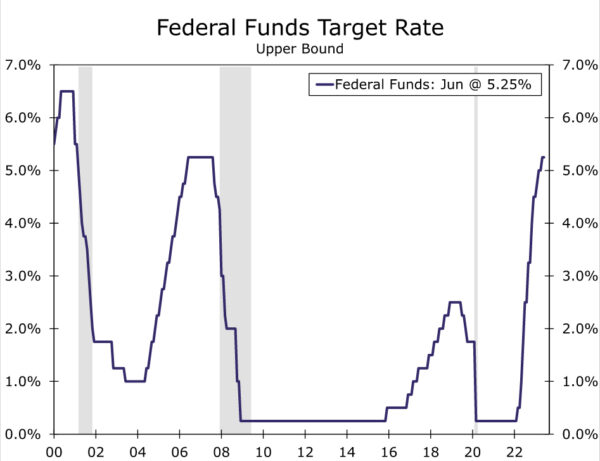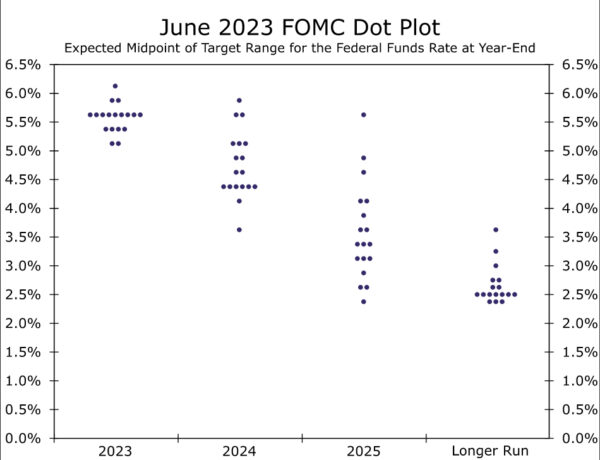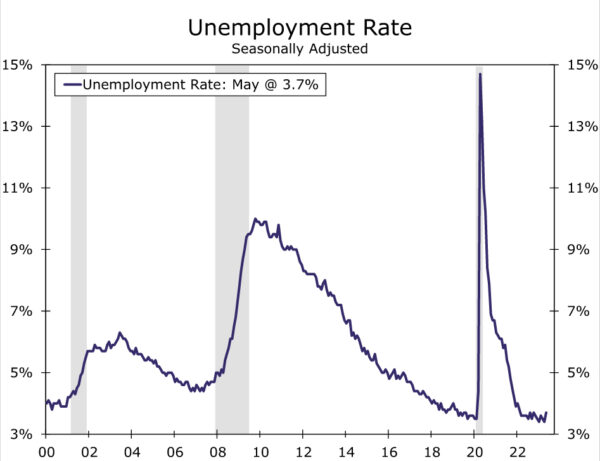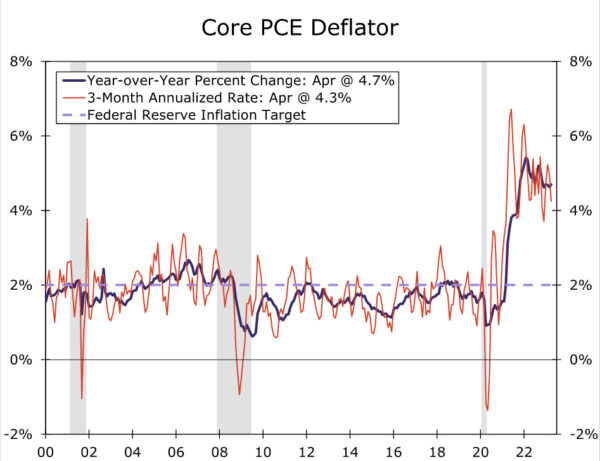Summary
- As widely expected, the FOMC decided unanimously to refrain from raising rates at today’s meeting.
- However, the Committee continued to say that “additional policy firming” may be appropriate. Furthermore, the median dot for 2023 shifted up by 50 bps. That is, most FOMC members believe that another 50 bps of tightening may be appropriate by the end of 2023. Prior to the meeting, the bond market was priced for only 25 bps of additional tightening.
- The Committee lowered its forecast of the unemployment rate at year-end 2023 and lifted its outlook for core PCE inflation at the end of the year.
- None of the 18 FOMC members at present think that a rate cut by the end of 2023 would be appropriate.
- In our view, the year-over-year rate of core PCE inflation does not need to be precisely at 2% to lead the Committee to ease policy. But, the FOMC does need to see evidence that it is heading back toward 2% on a sustained basis. We do not think that evidence will be forthcoming this year.
- We look for the FOMC to raise rates by another 25 bps at its next meeting on July 26 before calling it quits. But, we readily acknowledge that the risks to our fed funds rate forecast are skewed to the upside.
FOMC on Hold, But Leaning Toward More Tightening
As widely expected, the Federal Open Market Committee (FOMC) refrained from hiking rates at its policy meeting today, which is the first time in 11 meetings that the Committee left the fed funds rate unchanged (Figure 1). The decision to keep the target range at 5.00%-5.25% was supported by all 11 members who were eligible to vote at this meeting. The FOMC also decided to keep its pace of quantitative tightening unchanged. That is, the Federal Reserve will allow up to $60 billion of Treasury securities and up to $35 billion of mortgage-backed securities to roll off its balance sheet every month.
Today’s post-meeting statement was little changed from the last statement on May 3. The Committee continued to note that economic activity is expanding at a “modest pace” and that unemployment remains low and inflation “remains elevated.” The FOMC said that its decision to keep rates on hold would give it the ability “to assess additional information and its implications for monetary policy.” The Committee re-iterated the phrase that it first used in the May 3 statement. That is, it will consider a number of factors to determine the extent that “additional policy firming may be appropriate to return inflation to 2 percent over time.” These factors include “the cumulative tightening of monetary policy, the lags with which monetary policy affects economic activity and inflation, and economic and financial developments.”
Dot Plot Shifts Up
According to the Summary of Economic Projections (SEP), which the FOMC releases four times per year and outlines its macroeconomic forecasts, most members of the Committee believe that additional policy firming may be appropriate this year. That is, the so-called “dot plot” that was released following the March 22 meeting showed that the median FOMC member thought that a fed funds target range of 5.00%-5.25% would be appropriate at the end of 2023. The dot plot that was released today showed the median dot shifting up to a range of 5.50%-5.75% at the end of this year (Figure 2). In other words, the median FOMC member believes that another 50 bps of tightening will be needed by the end of the year “to return inflation to 2 percent over time.” As we go to print, the bond market remains priced for only one more 25 bps rate hike by the end of 2023, most likely at the July meeting.
Why the change in the dots? The answer: the FOMC changed its forecasts of unemployment and inflation. As shown in Figure 3, the unemployment rate remains exceptionally low at present, and the Committee nows sees it rising to only 4.1% by the end of 2023 (the median participant in March forecasted it rising to 4.5% at the end of the year.) Additionally, the median forecast for the core rate of PCE inflation at year-end 2023 was lifted from 3.6% in March to 3.9% today. Interestingly, none of the 18 FOMC members at present thinks that a rate cut by the end of the year would be appropriate.
What will the FOMC need to see to start easing policy? Barring some unforeseen negative shock to the economy in the near term, the Committee wants to see evidence that inflation is returning to 2% on a sustained basis. As shown in Figure 4, the rate of inflation has eased marginally in recent months but only an optimist would look at that chart and see evidence that inflation is returning to 2%. In our view, the year-over-year rate of inflation does not need to be precisely at 2% before the Committee begins to ease policy. But, our forecast is that the core PCE deflator will increase at an annualized rate of 2.8% in Q4-2023 relative to Q3-2023, which we think is still too hot to induce the FOMC to cut rates. Consequentially, we do not look for a rate cut this year, which is consistent with the FOMC’s thinking at present.
The next FOMC meeting is scheduled for July 26. We expect that the continued resilience of the economy and the elevated rate of inflation will lead the Committee to hike by another 25 bps at that meeting. Indeed, Chair Powell stated in his post-meeting press conference that the July FOMC meeting will be a “live meeting.” We then look for the Committee to remain on hold for the remainder of the year. However, given today’s dot plot, we readily acknowledge that the risks to our fed funds forecast are skewed to the upside. We think it will take a modest recession early next year, which will help to bring inflation lower, to induce the FOMC to ease policy. See our most recent U.S. Economic Outlook for details of our forecast.
















